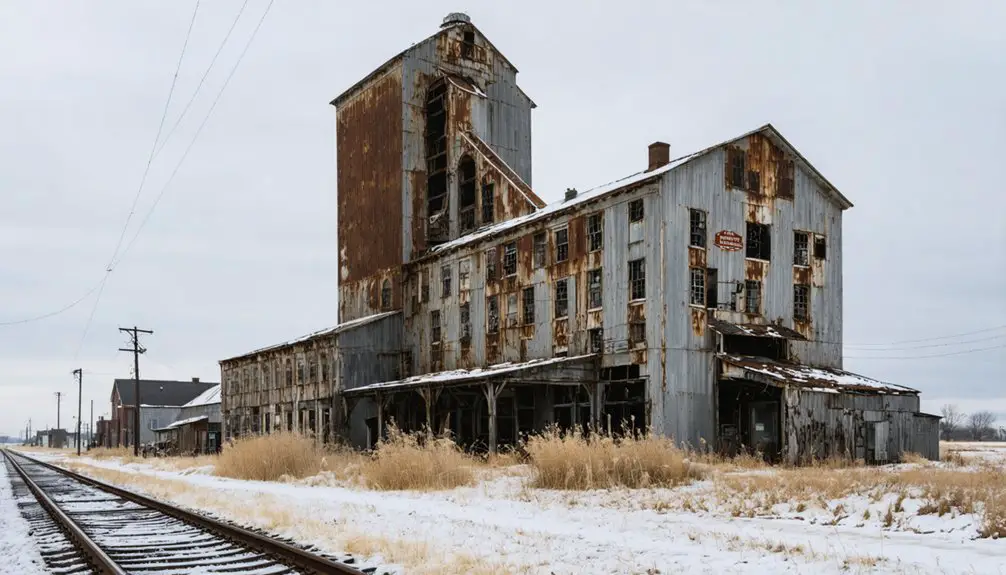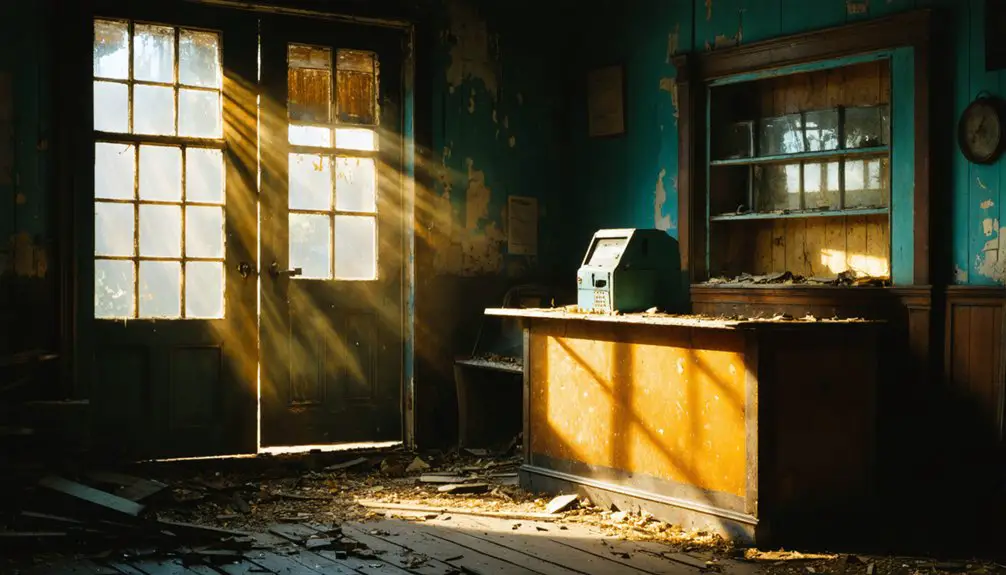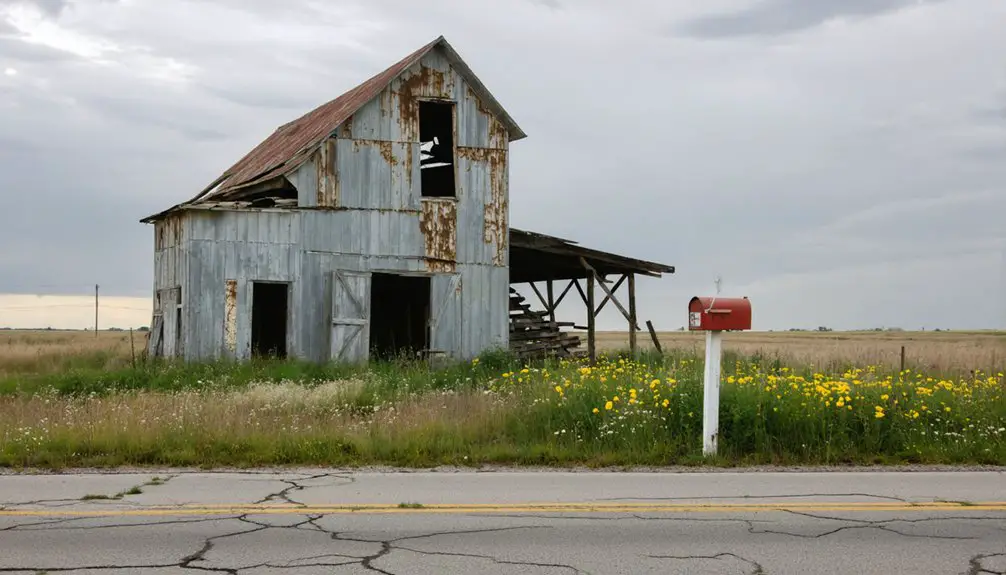You’ll discover Parkton’s story in the remnants of a pioneering Minnesota town that thrived in the 1860s. Early settlers built a vibrant agricultural community, complete with grain mills, blacksmith shops, and a bustling general store. When railroad politics shifted and nearby towns secured coveted rail connections, Parkton’s isolation led to its gradual decline. The weathered foundations and forgotten ox cart trails hold secrets about transportation’s power to shape frontier destinies.
Key Takeaways
- Parkton was once a thriving Minnesota frontier town that declined due to its failure to secure crucial railroad connections in the late 1800s.
- The closure of essential services like the post office and general store marked the beginning of Parkton’s transformation into a ghost town.
- The town’s economic vulnerability stemmed from lack of diversification and isolation from major transportation routes, leading to population decline.
- Parkton’s location on early ox cart trails initially supported growth, but nearby towns with railroad access ultimately drew businesses away.
- The community’s gradual exodus occurred in the early 1900s as businesses closed and families migrated elsewhere for better opportunities.
Early Settlement and Pioneer Life
While indigenous peoples had inhabited the Minnesota region for thousands of years, Parkton’s pioneer settlement began taking shape in the mid-1880s as European-American settlers pushed northward along the region’s waterways.
You’d have found these early settlers facing numerous pioneer challenges as they carved out homesteads from the rugged frontier. Many homesteaders earned their living by cutting and selling wood. They’d gather at religious meetings and community events, finding strength in their shared experience of harsh winters and isolation.
The cultural adaptation from Native American to European-American land use transformed the landscape, where ancient burial mounds still dotted the terrain. Life centered on subsistence farming, fishing, and hunting, with rivers serving as vital lifelines for trade and communication before modern infrastructure arrived. The Anishinaabe and Dakota peoples had established extensive trading networks throughout the region long before European settlement.
Rivers and ancient burial mounds marked a landscape transformed, as European settlers adapted Native lands for farming, fishing and trade.
Each family’s survival depended on their ability to work the land while building connections with neighboring homesteaders.
The Rise of Agriculture and Local Industry
You’ll find that Parkton’s earliest settlers established subsistence farms in the 1860s, preserving their harvests and gradually shifting to commercial wheat production as railroads reached the area.
Local grain mills soon sprang up along the creek, providing essential services to area farmers who’d mortgaged their land and equipment to expand operations. Many farmers struggled with high transportation costs from railroad monopolies that cut deeply into their profits. The Order of Patrons of Husbandry formed in 1867 to help farmers fight against these unfair practices.
As the farming community grew more prosperous, you’d see blacksmith shops, general stores, and other small industries take root to serve the increasing population’s needs.
Early Farming Settlements Emerge
The rich farmland around Parkton first attracted Euro-American settlers in the mid-1800s, following patterns established near Fort Snelling and the Red River Valley trading posts.
As settler communities emerged, you’d find families building sod homes and breaking the prairie soil with steel-blade plows. The Homestead Act of 1862 accelerated this growth, bringing waves of newcomers enthusiastic to claim their 160-acre parcels.
Early crop cultivation reflected the diverse agricultural knowledge of Native Americans and European immigrants, particularly Norwegian settlers who clustered in the region. Settlers learned from Dakota tribes who had traditionally grown Three Sisters crops along the riverbanks.
They planted hardy varieties of corn, potatoes, and turnips while adapting their farming techniques to Minnesota’s unique climate. Local industries soon followed, with timber operations and sawmills supporting the growing farming community.
Grain Mills Drive Growth
During Parkton’s agricultural boom of the late 1860s, grain mills emerged as essential economic engines that transformed the region’s farming landscape. You’d find cutting-edge milling technology at operations like the Ames Mill, where innovative middlings purifiers produced superior flour that earned national recognition at the 1876 Centennial Exposition. At the industry’s peak, twenty-two mills operated along the Cannon River between Morristown and Northfield.
These mills weren’t just processing centers – they drove economic diversification throughout the area. You could see how they created direct markets for local wheat farmers, reduced transportation costs, and attracted complementary businesses. The arrival of the railroad in 1857 revolutionized the local mill industry by enabling faster and more efficient transportation of goods.
The mills’ adaptable timber-frame construction let operators quickly upgrade to new machinery, while their strategic locations near water power and railways connected Parkton’s products to national markets. Year-round employment at the mills anchored the rural population and supported a network of related trades.
Local Industries Take Root
As Minnesota farmers shifted from subsistence to commercial agriculture in the 1860s, Parkton’s agricultural landscape transformed dramatically through calculated risks and innovation.
Like many early Minnesota settlements, Parkton played a role in the state’s Agricultural Society mission of promoting farming advancements and education.
You’d have seen local farmers mortgaging their land to invest in wheat production, despite challenges with railroad costs and unorganized distribution networks.
Like other parts of Minnesota experiencing rapid changes after World War II, Parkton’s environment faced mounting pressures from technological advancements that reshaped the natural landscape.
Daily Life in Parkton’s Heyday
Life in Parkton centered around an intricate web of community connections and daily routines that shaped the frontier town’s character.
You’d find yourself participating in community gatherings at the schoolhouse or joining seasonal markets at the general store, where neighbors traded goods and stories.
Daily survival meant working from sunup to sundown. You’d tend to your crops, care for livestock, and maintain your modest wooden home.
If you weren’t farming, you might’ve operated the sawmill, worked as a blacksmith, or run the boarding house. The post office kept you connected to the outside world, while the general store supplied what you couldn’t produce yourself.
When hardships struck – whether grasshopper plagues or harsh winters – you’d rely on your neighbors, sharing resources and labor to keep the community alive.
Like many settlements during the Panic of 1857, Parkton residents faced severe economic uncertainty that tested their resilience.
Economic Challenges and Turning Points

While Parkton initially thrived on its industrial foundations, the town’s heavy reliance on a single economic engine would ultimately prove fatal.
You would’ve seen the writing on the wall as nearby transportation hubs drew businesses away, leaving Parkton increasingly isolated from crucial market connections.
The lack of economic diversification made the town particularly vulnerable when hard times hit.
As the main industry faltered, you’d have witnessed a domino effect: workers paid in company store credit couldn’t build independent wealth, property values plummeted, and foreclosures mounted.
Soon, wealthy families and corporations swooped in to consolidate land ownership.
When essential services like the post office and general store finally closed their doors, it marked the point of no return.
Residents had little choice but to seek opportunities elsewhere.
Transportation’s Role in the Town’s Fate
Despite being strategically located on early ox cart trails, Parkton’s fate hinged on its inability to secure crucial railroad connections in the late 19th century.
Like nearby Perkinsville, which lost out to Maple Plain, Parkton watched as railroad influence shaped the region’s destiny, bypassing their community in favor of politically connected towns.
Railroad politics doomed Parkton’s future, as lucrative rail lines favored well-connected towns over this once-promising settlement.
You’ll find that transportation networks evolved rapidly during this period, and communities without rail access faced devastating consequences.
As the St. Paul & Pacific railroad established new routes, Parkton’s businesses struggled to ship goods, settlers looked elsewhere, and economic opportunities dwindled.
The town’s story mirrors other Minnesota ghost towns like Elcor and Dorothy, where railroad abandonment spelled their doom.
Without modern transport infrastructure, Parkton couldn’t adapt to changing times, leading to closed storefronts and eventual abandonment.
The Final Years and Abandonment

As Parkton entered the early 1900s, the town’s economic foundation crumbled under mounting pressures from declining natural resource demand and dwindling commerce.
You’d have seen the gradual exodus of families as businesses shuttered their doors and essential services disappeared.
The last residents, mostly older folks with deep roots in the community, held on as long as they could, watching their beloved town slowly fade away.
Legacy and Historical Significance
Through its role as a essential railway station, Parkton left an indelible mark on Minnesota’s development during the late 19th and early 20th centuries.
Parkton’s railway legacy shaped Minnesota’s frontier growth, serving as a vital transportation link during America’s railroad era.
You’ll find its story woven into the fabric of the state’s cultural heritage, representing countless small towns that rose and fell with the railroads. As a ghost town today, Parkton serves as a compelling reminder of how transportation technologies can shape community destinies.
When you explore Parkton’s history, you’ll discover more than just another abandoned settlement – it’s a window into Minnesota’s economic evolution.
The town’s transformation from a bustling railway hub to a ghost town illustrates the broader changes that reshaped rural America, making it a valuable case study for historians and a reflection of the dynamic nature of frontier development.
Frequently Asked Questions
What Indigenous Artifacts Have Been Discovered at the Parkton Site?
You’ll find diverse artifact significance in excavation findings: stone tools like bifaces and projectile points, copper implements, and organic remains including burnt bones from beaver, muskrat, and caribou.
Are There Any Surviving Photographs of Parkton’s Original Buildings?
Poring through preserved records, you won’t find any surviving photographs of the original buildings. Despite efforts in historical preservation, no images documenting the architectural significance of these structures have been discovered.
Did Any Paranormal Activity Reports Emerge After Parkton’s Abandonment?
You won’t find verified ghost sightings or urban legends from Parkton after its abandonment. Unlike other Minnesota ghost towns with rich paranormal histories, there aren’t any documented supernatural events from this location.
Which Families Were the Last to Leave Parkton?
You’ll find limited records of Parkton’s last families, but they were likely small-scale farming households who relocated to nearby railroad towns when economic pressures and crop failures made staying unsustainable.
Can Visitors Legally Explore the Parkton Site Today?
Like a locked garden, you can’t freely wander Parkton today. Without clear visitation regulations and exploration guidelines, you’ll need to verify property ownership and obtain permission to visit legally.
References
- https://www.minnesotahistory.org/post/a-complete-guide-to-the-ghost-towns-of-hennepin-county
- https://www.youtube.com/watch?v=5bCG6B2rzZY
- https://quickcountry.com/minnesota-ghost-towns/
- https://www.geotab.com/ghost-towns/
- https://en.wikipedia.org/wiki/Elcor
- https://en.wikipedia.org/wiki/History_of_Minnesota
- https://lakeofthewoodshistoricalsociety.com/archives/
- https://www.blueearthcountymn.gov/164/History
- https://www.minnesotafunfacts.com/early-explorers-settlers/
- https://lakeofthewoodshistoricalsociety.com/the-forest-area/



